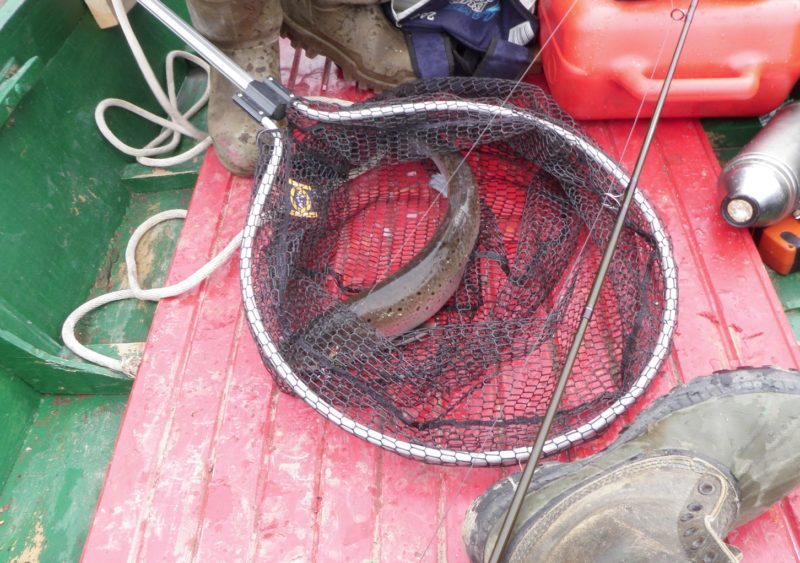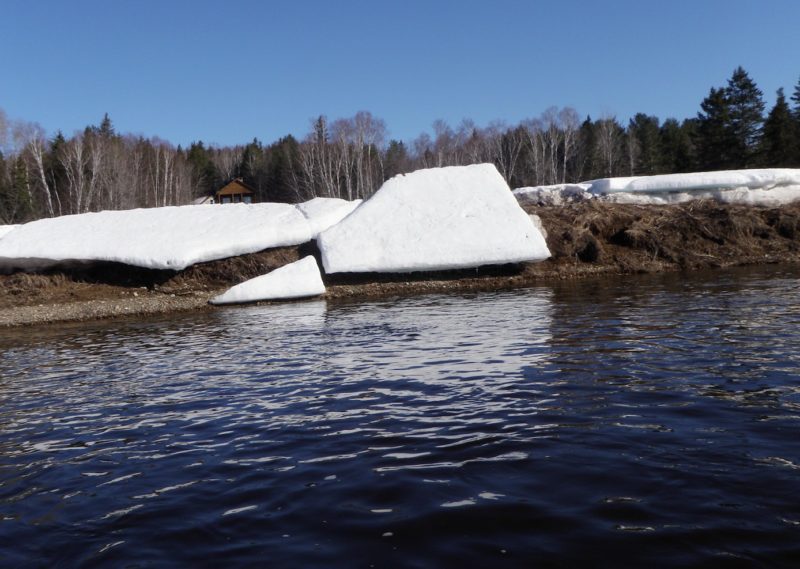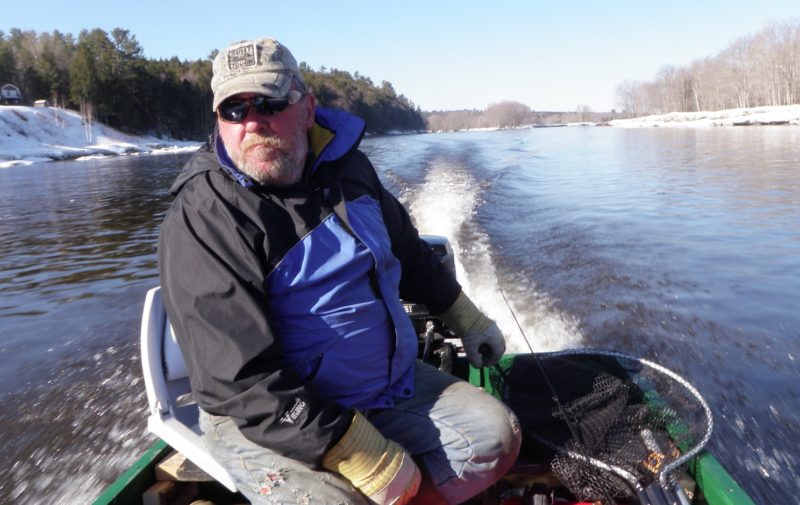I was fishing the Southwest Miramichi in New Brunswick for Atlantic salmon. Five feet banks of snow and ice lined much of the river. I was in a fragile wooden two-man fishing boat with David, my guide, my eight-weight fly rod, and my heart in my mouth. I had a salmon on. He had been on for five minutes and out of the water once – my first Spring-run salmon; a grilse.
A few moments before, David had warned, “Ice going to pass us on the left, move your rod to the right side of the boat.”
I watched him put a few inches of slack onto the anchor rope and then heard the crack and squeak of ice as the current swept a snowplow-sized chunk against and past our boat’s side – a scraping, glancing blow. The jumping of my rod as the salmon pulled and struggled refocused me and after the half-ton of ice had passed, we netted and released the blackfish.
‘Blackfish’ is the name used by New Brunswick guides and fishermen for Spring-run Atlantic salmon. After a winter spent under the ice in the Miramichi River system, the silver gleam of the salmon has turned dark green in color and they remain dark until their return to the sea.
The mix of ice, snow, current and hard-fighting salmon make the fly fishing exciting. Sometimes, too exciting. I’d rather have the ice and the salmon come one at a time. That would be enough excitement for me.
George, a member of the Miramichi Anglers Association, had invited me to join him. Spring-run Atlantic salmon, big steamers, an eight to ten weight fly rod, second week of the season in New Brunswick — I eagerly accepted. The email read: “We had to cancel our first week because the ice was still on the river, but your week looks good. Plan on it.”
Plan on it? I was already packed! It was a long drive from New Hampshire to Doaktown, New Brunswick but I broke it up with stops for coffee and snacks, a visit to L. L. Bean and, as I arrived in Doaktown, I stopped for directions and information at Doak’s, the world-renowned fly shop. The news: The melt was a couple of weeks late; the locals had been catching salmon for three days; there was still a lot of ice floating down the river.
While I was there, I bought some recommended flies – Christmas Trees, Black Ghosts and such. Glitter and flash were a necessity for visibility in the rough water.
It turned out to be a magical trip. New friends, new fishing experiences with heavy line and big streamers, ice cakes the size of pickup trucks to be dodged – one went past us with a ten-foot tree trunk sticking out of it like a ship’s ram – and there were a few fish as well. My best was 32 inches. But let me tell you about a bigger one; the one that got away.
On the second day the fishing was slow. David and I were eight hours on the river with an hour’s break for lunch. David was kept busy dodging ice and I was starting to get used to a 300-grain sinking line. It had progressed from feeling like I was casting an anvil to casting a pound sack of nails. This was much different from the floating line I was accustomed to use.
I had caught the aforementioned grilse on the first day but had hooked only one fish since. That battle lasted for a whole second and a half. Fish on, fish off. Frustrating.
It was 3:20 in the afternoon. The same time we had netted yesterday’s grilse. (Yesterday’s grilse – there is a song there, somewhere.) We were fishing near a bridge. I cast toward shore and let the fly drift. At the end of the drift, I waited a couple of seconds, brought in some line and ‘wham.’ A fish hit. I set the hook and watched as the salmon left the water, shaking and pulling. I remembered to bow to the salmon.
“That’s a big fish!” I shouted.
“Yeah,” David agreed. “Let him run a bit. Tire him out. Don’t try to bring him in fast, he’ll break off. This is a good one.”
As if I had any way to bring him at all! The line was screaming off the reel and the rod dancing in my hand. I was in the middle of the boat and David was in the stern.
“He’s turning. Bring in the slack.” David coached. “Keep him moving toward us.”
The fish leapt out of the water shaking, then once more changed his direction. As I bowed to him, he took twenty yards of line and ran. But gradually, my reel and rod were winning. He was getting closer.
David got the net ready. The fish was at the stern near the motor and David’s net couldn’t get to him. The fish spotted the net and took off again. Thirty yards of line and more, into the white. Out of the water again and more line out. This was a big, strong fish.
The tugs seemed a bit weaker and I got some line back. Then more and more. He was coming. I got him even with David and brought him close. David got the net ready. The fish looked weak and started to turn belly up. David reached with his net. The salmon saw the flash of metal and, from somewhere, found the strength to run again.
Thirty feet. Still fighting but diminished, and then – pop—my line and barbless fly came flying out of the river. The Black Ghost almost hit me in the head. The fish was free. I saw a flash on the surface and he was gone. A big, beautiful, strong and game salmon, now free and undiminished, swam deep into my memory.





